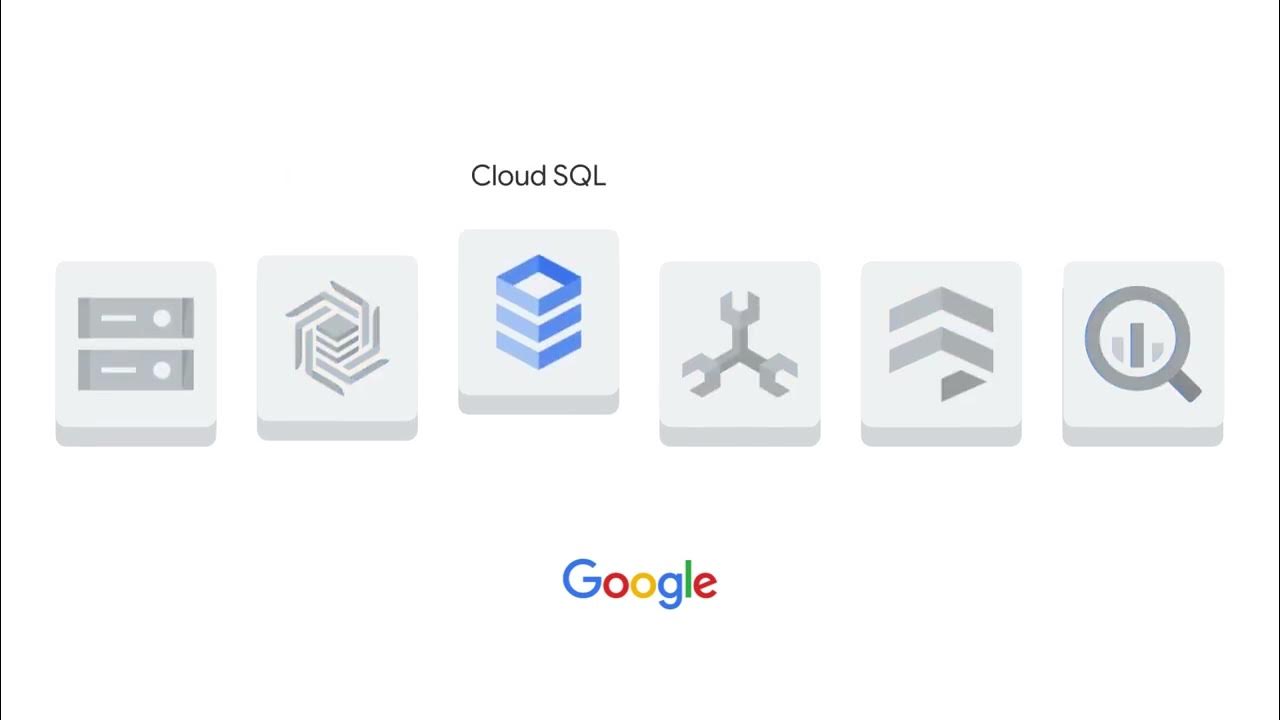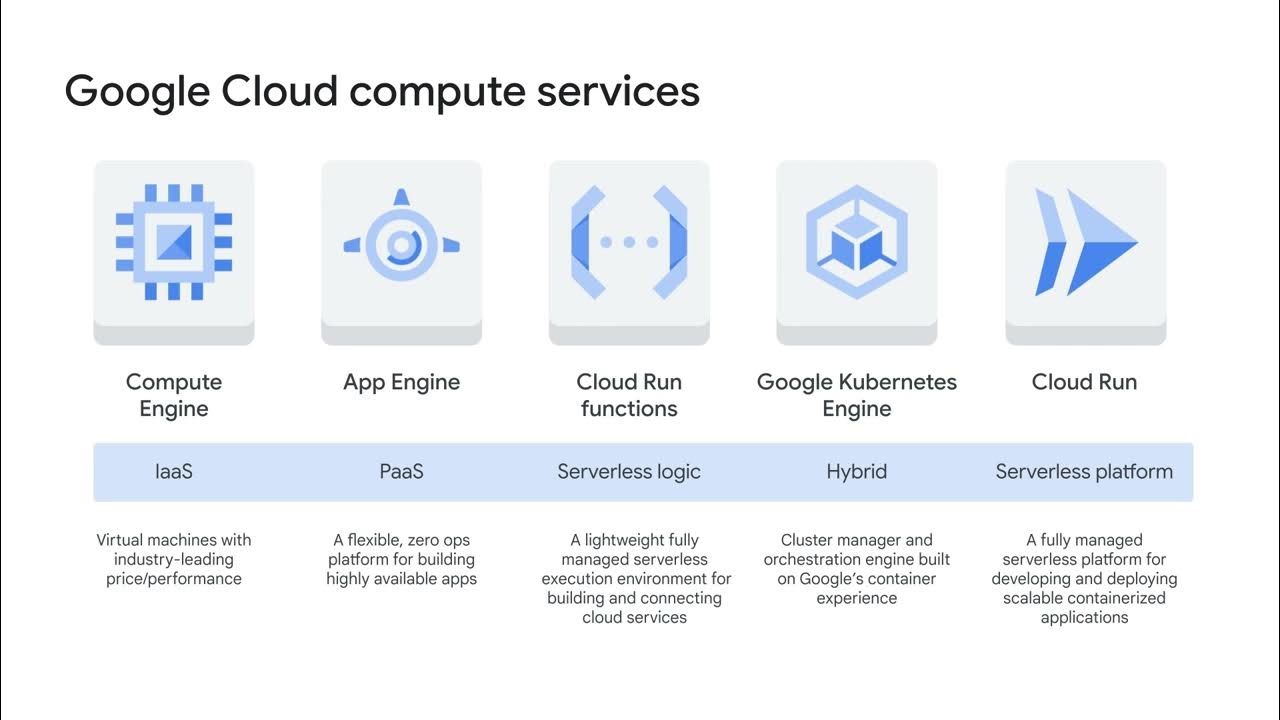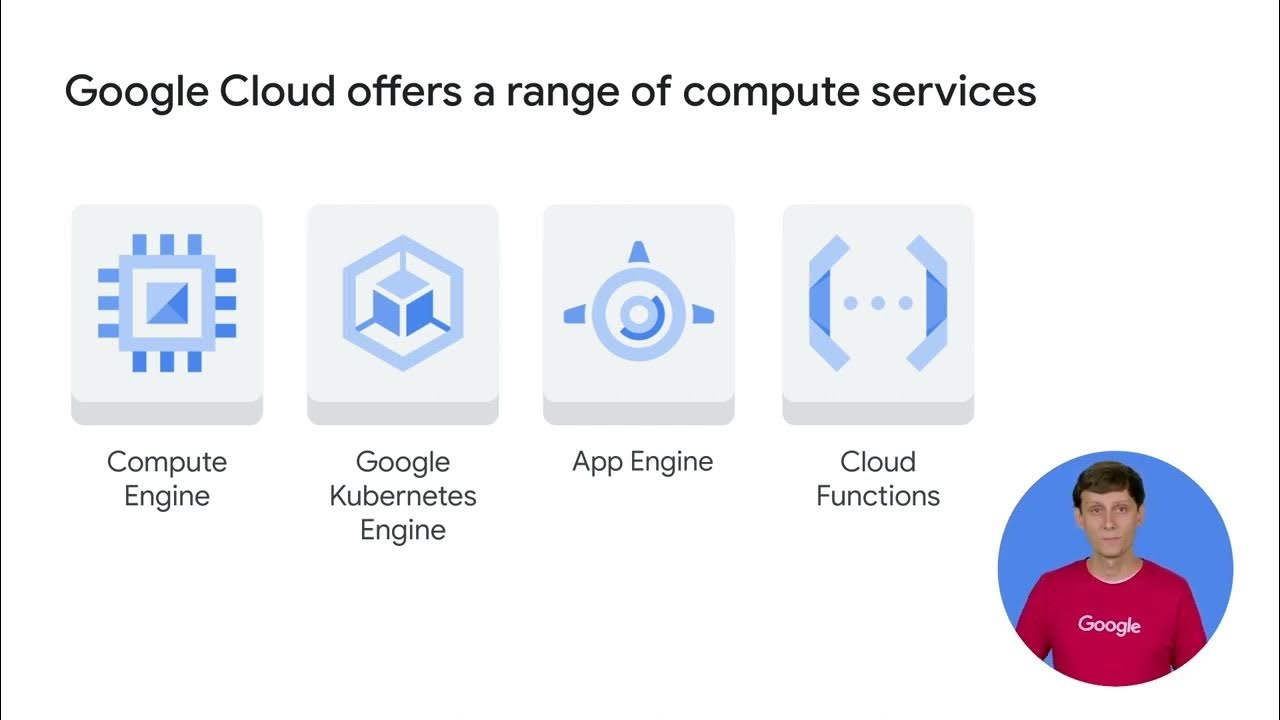Compute Options Available In Google Cloud Platform
Summary
TLDRIn this video from Cloud Ania Analytics, the presenter introduces various compute options available in Google Cloud. The video covers four main compute services: Compute Engine, Google Kubernetes Engine (GKE), App Engine, and Cloud Functions. Compute Engine and GKE are server-based, while App Engine and Cloud Functions are serverless. The video provides a basic overview, explaining the differences between these services and when to use them. Upcoming videos will explore these compute options with practical labs and in-depth explanations. Viewers are encouraged to like, comment, and subscribe for more content.
Takeaways
- 💻 Google Cloud offers four main compute options: Compute Engine, Google Kubernetes Engine, App Engine, and Cloud Functions.
- 🔧 Compute Engine is an infrastructure-as-a-service (IaaS) solution allowing users to run virtual machines on demand, with full flexibility for configuring machine types and storage.
- 🖥️ Google Kubernetes Engine (GKE) runs on top of Compute Engine and enables containerized applications to be managed efficiently with administrative control from the user.
- 📦 Containerization through GKE allows for highly portable, resource-efficient applications.
- ☁️ App Engine is a fully managed platform-as-a-service (PaaS), where users focus only on their code, and Google manages the infrastructure and resource provisioning.
- 🌍 App Engine is regional, while Compute Engine and Google Kubernetes Engine are zonal resources in Google Cloud.
- ⚙️ Cloud Functions is an event-driven, serverless compute option that triggers code in response to specific events, making it a straightforward solution for single-purpose applications.
- 🚀 The difference between server-based and serverless services was briefly introduced, with more detailed explanations to follow in future videos.
- 📜 The video is an introductory session, focusing on theoretical aspects, and practical labs will be covered in upcoming content.
- 🔗 Viewers are encouraged to engage through comments and subscribe for future content focused on Google Cloud services.
Q & A
What are the different compute options available in Google Cloud?
-The four compute options in Google Cloud are Compute Engine, Google Kubernetes Engine (GKE), App Engine, and Cloud Functions.
What is Compute Engine and when should it be used?
-Compute Engine is Google's Infrastructure as a Service (IaaS) solution that lets users run virtual machines (VMs) on demand. It should be used when users need full control over their VM instances, including the operating system and configuration.
How is Google Kubernetes Engine (GKE) different from Compute Engine?
-Google Kubernetes Engine (GKE) is built on top of Compute Engine and focuses on managing and orchestrating containers. While Compute Engine provides raw VMs, GKE simplifies containerized application management, offering easier scalability and portability.
What is App Engine in Google Cloud?
-App Engine is Google's Platform as a Service (PaaS) offering, which allows users to deploy applications without worrying about the underlying infrastructure. Users can focus on their code while Google manages the provisioning and scaling of resources.
How does Cloud Functions differ from other compute options?
-Cloud Functions is an event-driven, serverless compute option in Google Cloud. It executes code in response to specific events, making it ideal for lightweight, single-purpose tasks without the need to manage servers.
What is the difference between server-based and serverless compute options?
-Server-based options, such as Compute Engine and Google Kubernetes Engine, require users to manage server infrastructure. Serverless options, such as App Engine and Cloud Functions, abstract the infrastructure management, letting users focus solely on their code.
Why is Compute Engine called the basic building block of Google Cloud?
-Compute Engine is referred to as the basic building block because it provides raw VMs, allowing users to configure their infrastructure as needed. It offers the most flexibility for custom configurations in cloud environments.
What are the benefits of using containers in Google Kubernetes Engine (GKE)?
-Containers in GKE offer high portability and efficient resource usage. They allow users to package applications and their dependencies into isolated environments, making them easy to move between environments and scale as needed.
What is meant by App Engine being a 'regional' resource?
-App Engine is a regional resource, meaning it operates within a specific region in Google Cloud. This is in contrast to zonal resources like Compute Engine and GKE, which operate within individual availability zones.
What kind of applications are ideal for Cloud Functions?
-Cloud Functions is ideal for event-driven applications, where code needs to be executed in response to specific events, such as HTTP requests or changes in data. It is suitable for lightweight, single-purpose tasks.
Outlines

このセクションは有料ユーザー限定です。 アクセスするには、アップグレードをお願いします。
今すぐアップグレードMindmap

このセクションは有料ユーザー限定です。 アクセスするには、アップグレードをお願いします。
今すぐアップグレードKeywords

このセクションは有料ユーザー限定です。 アクセスするには、アップグレードをお願いします。
今すぐアップグレードHighlights

このセクションは有料ユーザー限定です。 アクセスするには、アップグレードをお願いします。
今すぐアップグレードTranscripts

このセクションは有料ユーザー限定です。 アクセスするには、アップグレードをお願いします。
今すぐアップグレード5.0 / 5 (0 votes)






